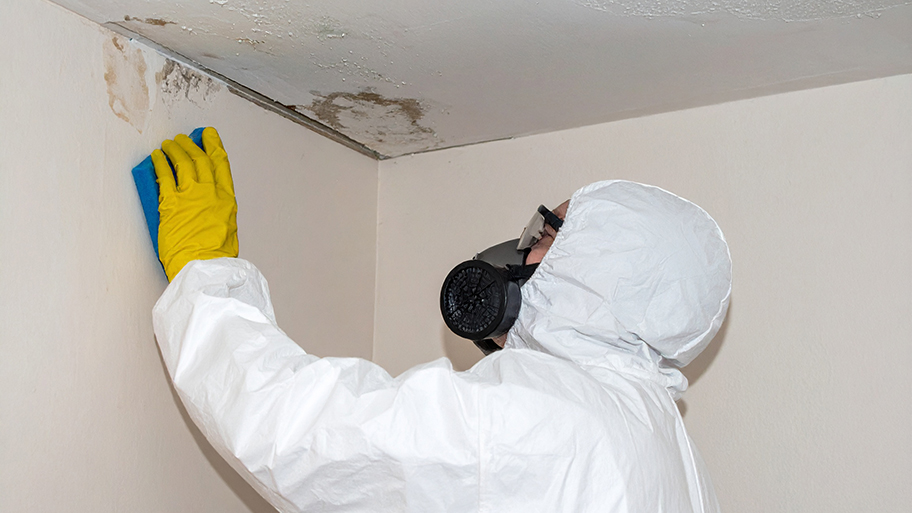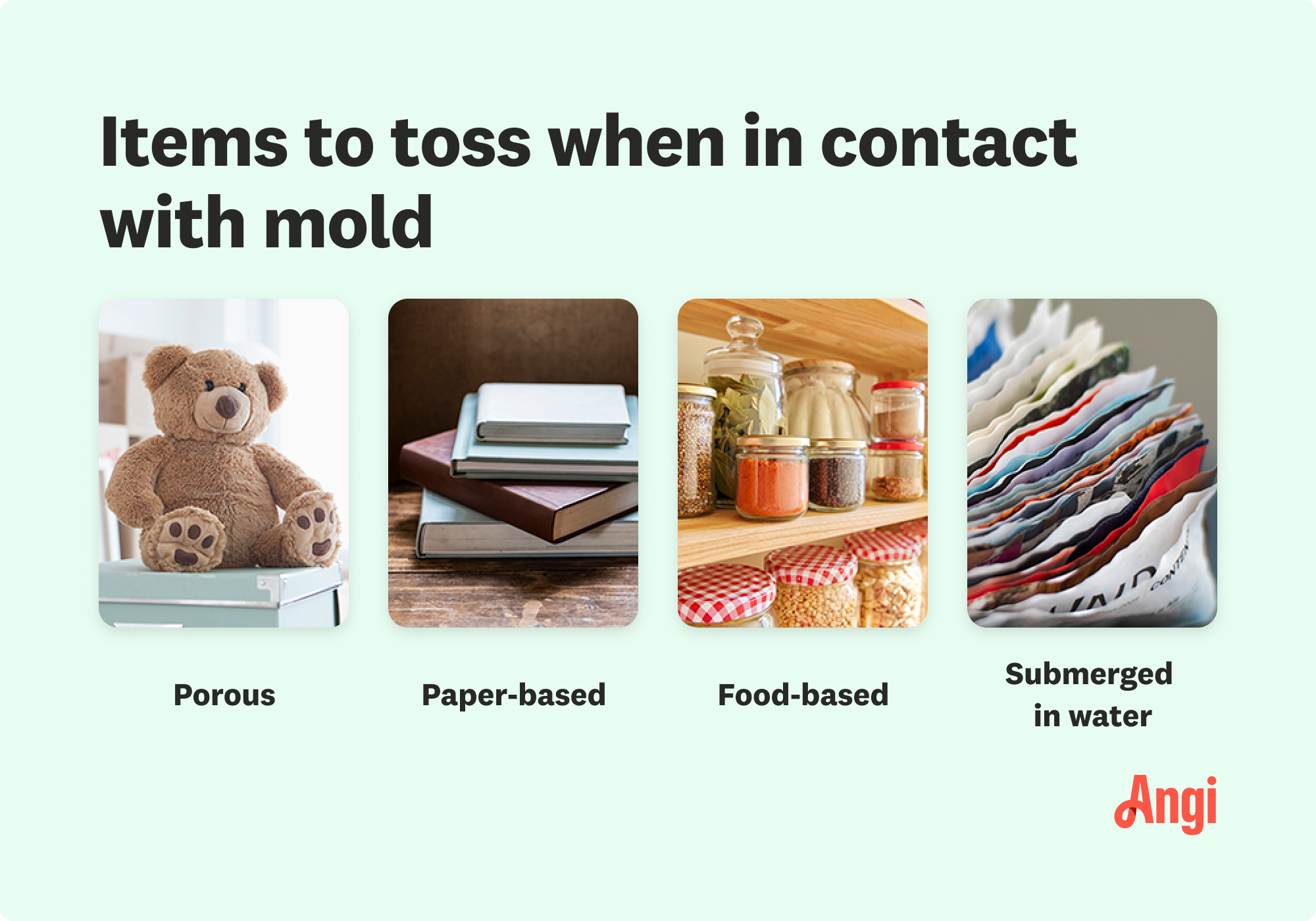
Mold remediation cost can quickly escalate. But if you have mold in your home, the cost for mold remediation is worth it.
Say goodbye to the mold hiding in your basement


Mold loves to grow in basements—the warm and wet conditions are everything mold spores look for in a home. Unfortunately, mold can cause extensive home damage and negative health conditions for residents.
If you notice mold growth in your basement, it is important to remove it as soon as possible. This guide details how to get rid of mold in the basement and keep it from coming back.
While there may be various surfaces and materials in your basement, you can divide them into two broad categories: porous and non-porous. It can be more challenging to get rid of mold from a porous surface, as the mold filaments can penetrate into the crevices and openings of the material. The type of product you can use to clean mold depends on the material type.
If unfinished, drywall is a porous material. But once you paint or prime drywall, you create a hard, non-porous surface. How you go about tackling a moldy patch of drywall depends on whether you've painted it or not.
If the wall is painted or otherwise finished, a soapy bleach solution can be an effective mold-remover. Mix 1 cup bleach with 2 cups water and 1 tablespoon of dish soap. Dip a sponge in the solution (remembering to wear gloves), then wipe on the moldy area. Toss the sponge when finished, then allow the area to dry.
To remove mold from unfinished drywall, your best bet is to remove the affected patch of drywall entirely. Since that can be a complicated and messy project that risks spreading mold spores around, your best bet is to call in a professional.
You can remove mold from carpet if it covers only a small area, but for a larger area, you're better off hiring a professional. In some cases, the best option is to remove and discard the carpeting altogether.
To clean a small area, you'll want to use a mold-killer that will penetrate the carpet's fibers without discoloring or weakening them. Vinegar is usually your best bet. Combine equal parts distilled white vinegar and water in a spray bottle, then mist it over the area. Let it soak in for about one hour, then scrub with a rag or soft brush.
If you see mold growing on upholstery or other fabric in your basement, tackle it the same way you'd tackle mold on carpets, using a 1:1 mixture of vinegar and water. Only try to remove the mold if it's in a small area. You may have to discard the fabric if the mold is all over it.
For clothing that's become moldy after basement storage, try soaking it in a 1:1 vinegar/water solution, then launder using the warmest water the clothes can handle. Hang the clothing out in the sun to dry, as putting it in the dryer can set any remaining mold stains.
How you remove mold from wood depends on whether it's finished or unfinished. For finished or painted wood, you can use the same bleach and dish soap solution you would to remove mold from finished drywall.
To remove mold from unfinished wood, use vinegar, mixed with an equal amount of water. Spray on the wood and let it saturate the moldy area. Let it soak, then dry. You may also sand the wood, after cleaning it, to remove any visible mold or mold spores beneath the surface.
When mold grows in your ductwork, the best option is to hire a professional to deep clean the ducts and safely remove the mold. But, if it's only on a small area, you can try to remove the mold on your own.
Soak a sponge or rag with a 1:1 vinegar/water solution, then wipe it onto the affected area. Use a gentle scrubbing motion to remove the mold, then allow it to dry.
When a pipe leaks, it can create the ideal conditions for mold to grow. If you see mold growing on the outside of a PVC pipe, use a very diluted bleach solution, 1 part bleach to 16 parts water, to clean it away. You'll also want to repair the leak to keep the mold from coming back.
You may be surprised to learn that concrete is a porous material. It's full of nooks and crannies for mold to call home. If you have a small area of mold on a concrete wall or floor, use a 1:1 vinegar and water solution to clean it.
Spray or pour the vinegar solution onto the affected area, then let sit for at least 15 minutes. Scrub with a brush or sponge, then let dry.

Mold is a dangerous toxin, so it is important to take precautions to protect yourself before attempting any removal. The Environmental Protection Agency (EPA) recommends that homeowners do not take on DIY mold removal projects larger than 10 square feet. Contact a professional mold removal specialist to complete the job if needed.
Read through these safety recommendations before proceeding with how to kill mold in the basement.
Wear protective equipment: To protect your body and avoid inhaling any mold toxins, wear protective equipment, including an N95 mask, gloves, and eye goggles. You should also protect your skin by wearing a long shirt and pants.
Consider alternatives to bleach: Many homeowners reach for bleach when trying to kill mold; however, the product can be hazardous, and is not always the best option for mold removal. It tends to kill surface mold, but it leaves spores deeply embedded in cracks and holes.
Ventilate the area: Ensure your work area is well-ventilated. The mold will become airborne during the removal process, and you do not want to breathe it in. Open any windows and turn on a fan to circulate air.
If your basement currently has any of the signs of mold listed above, it is important to remediate the problem as soon as possible. Use one of these ways to get rid of mold in your basement.

If mold is growing on porous materials, it will be impossible to remove it all. Inspect your drywall, carpeting, curtains, or other porous materials in your basement for mold, and then remove and replace any items with visible growth.
Mold remediation that requires the removal of drywall can be difficult to contain. Any sort of demolition can cause spores to travel into your home’s HVAC system leading to potentially more harmful infestations. A mold removal pro will have the right tools and skills to contain it.
Use a pry bar to take down drywall or pull up any carpeting. Take down curtains and other textiles. Place all mold-infested materials in trash bags and remove them from your home. Dispose of the bags per local regulations.
You’ll need to combine some common household cleaners to make a mold-killing solution. When creating and using any of these mixtures, keep children and pets away from the area. You can make a water-based mold-killing solution with any of the following:
Vinegar: Combine one part undiluted vinegar with three parts warm water. This is a great solution for removing mold from basement walls.
Dish soap: Combine one part dish soap with three parts warm water. This solution is best for wood surfaces as it is not harsh enough to damage the finish.
Hydrogen peroxide: Apply a 3% solution of hydrogen peroxide (which is the strength typically sold at the drugstore) directly to moldy areas on hard, non-porous surfaces. Let sit for about 15 minutes, then wipe clean with a rag or sponge.
Borax: Combine 1 cup of borax with 1 gallon of warm water. You can boost the effectiveness of this solution by adding several teaspoons of soap, vinegar, or baking soda. This solution is great for basement walls or around plumbing.
Bleach: Be extra careful when using this bleach mixture. Combine ½ cup of bleach with 1 gallon of water. Keep in mind, bleach will kill mold, but it won’t always remove the dead spores.
Pour your water-based solution of choice into a spray bottle. Spray the solution across the entire mold-affected area. Use a microfiber cloth or towel to wipe away the sprayed solution and the accompanying mold.
If any mold remains after the initial wiping, spray more of the solution and let it sit for 30 minutes. Return and wipe away the area again. You can use a stiff-bristle brush to scrub at the surface. Let the entire area dry and repeat the process as needed.
Mold growth thrives in warm, moist areas, making many basements the perfect residence. The tiny spores break down organic debris in the environment, and mold spores spread when they come in contact with moisture.
A basement tends to be an area that collects moisture from leaky pipes or hot water heaters, pipe condensation, or rainwater that enters through holes or cracks. That’s why it’s important to waterproof your basement, as much as possible.
Mold is often black, white, or green in color. These colors can be camouflaged in basements, especially dim-lit areas like corners and ceilings, making it difficult to identify if you have a mold problem. Use these common signs of mold to assess whether or not you require mold remediation.
Mold gives off a pungent, earthy odor. It will be similar to the smell of a damp basement, but stronger and overbearing.
Dark speckles or stains found on walls or insulation are a signature sign of mold. Mold can be black, gray, green, or white, have pink, purple, or orange steaks, and have a flat or fuzzy texture.
Condensation on windows and pipes can indicate high humidity levels, and the perfect conditions for mold to grow.
While peeling paint is caused by moisture issues, it creates the perfect breeding ground for mold. Also, check for mold within the wall and foundation cracks.
The presence of mold can cause an allergic reaction for those living in your household. If anyone experiences sneezing, itchiness, watery eyes, or shortness of breath, mold could be the underlying issue.
Homeowners should take preventative measures to stop mold from growing in the first place. By implementing these steps in your basement, mold will no longer find a suitable spot to grow.
Eliminate basement moisture: There are many possible reasons for moisture in a basement. Start by identifying holes and cracks in the walls and floors, leaks in pipes or equipment, or pipe condensation, and take the proper steps to eliminate the source.
Use a dehumidifier: A dehumidifier will remove excess moisture from the air in your basement. Be sure to regularly empty the water vessel or consider installing a dehumidifier system that automatically drains.
Regularly change filters: Clogged filters can store moisture and spread mold throughout your home. Regularly change furnace and air conditioning filters to prevent this.
Ensure proper ventilation: Mold prefers damp, stagnant air. Keep your air circulating to avoid this condition. Make sure your whole-house ventilation system is properly functioning and open up windows for fresh air on occasion.
Install a sump pump: If your basement is prone to flooding or high humidity levels, installing a sump pump is a good idea. The pump keeps water from seeping into your basement, reducing flooding and helping it to stay dry.
According to data from Angi customers, most people (35.2%) need mold removed from their interior walls or ceiling, and 21.5% need mold removed from a basement or crawl space. Mold is commonly found in rooms that see a lot of moisture, so keep a lookout in your bathroom, kitchen, and basement. Call a pro as soon as you notice signs of mold to keep a small growth from becoming a much bigger problem.
As noted above, the EPA only recommends DIY-ing mold removal if the affected area is less than 10 square feet. For larger mold removal projects, be sure to call in the pros who will have the right tools and techniques for the job. Professional mold remediation costs anywhere from $1,130 to $3,350.
Basement mold remediation, specifically, will cost anywhere from $500 to $3,000. Hire a local mold removal team to test your home for mold, recommend what items and materials to remove and which ones to clean, and complete the mold removal process.
From average costs to expert advice, get all the answers you need to get your job done.

Mold remediation cost can quickly escalate. But if you have mold in your home, the cost for mold remediation is worth it.

The cost of a mold inspection might seem high, but it’s one of the best investments you can make for your health and home. Read on to learn cost-saving tips.

Common reasons for mold in kitchen cabinets include high humidity and leaks. Keep reading to learn more about why mold is growing in your kitchen cabinets.

What does black mold look like? It has a dark color and may appear slightly fuzzy. Use this guide to learn about the variations in black mold’s appearance.

Not sure what type of mold is forming in your home? We’re breaking down black mold vs regular mold.

Worried about mold in your central air conditioner? Learn how much it’ll cost to hire a pro vs. DIY this issue, and how to clean and disinfect your AC unit.